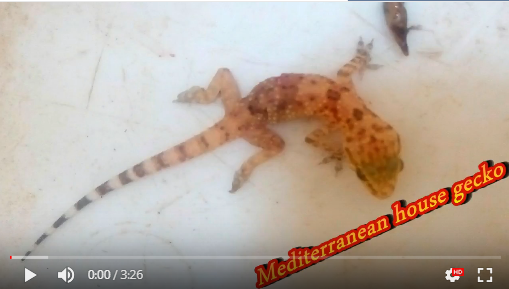عالم الطبيعة
Admin

المساهمات : 482
تاريخ التسجيل : 15/07/2009
 | |  Mediterranean house gecko Mediterranean house gecko | |
Mediterranean house gecko  The Mediterranean house gecko (Hemidactylus turcicus) (not to be confused with the Asian species Hemidactylus frenatus known as common house gecko) is a small gecko common to the Mediterranean which has spread to many parts of the world. It is commonly referred to as the Turkish gecko as represented in its Latin name and also as the "Moon Lizard" because it emerges in the evening. Snout rounded, about as long as the distance between the eye and the ear-opening, 1.25 to 1.3 the diameter of the orbit; forehead slightly concave; ear-opening oval, oblique, nearly half the diameter of the eye. Body and limbs moderate. Digits variable in length, the inner always well developed; 6 to 8 lamellae under the inner digits, 8 to 10 under the fourth finger, and 9 to 11 under the fourth toe. Head with large granules anteriorly, posteriorly with minute granules intermixed with round tubercles. Rostrum four-sided, not twice as broad as deep, with medial cleft above; nostril pierced between the rostrum, the first labial, and three nasals; 7 to 10 upper and 6 to 8 lower labials; mental large, triangular, at least twice as long as the adjacent labials, its point between two large chin-shields, which may be in contact behind it; a smaller chin shield on each side of the larger pair. Upper surface of body covered with minute granules intermixed with large tubercles, generally larger than the spaces between them, suboval, trihedral, and arranged in 14 or 16 pretty, regular longitudinal series. Abdominal scales small, smooth, roundish-hexagonal, imbricate. Males with a short angular series of 4 to 10 (exceptionally 2) preanal pores. Tail cylindrical, slightly depressed, tapering, covered above with minute scales and transverse series of large keeled tubercles, beneath with a series of large transversely dilated plates. Light brown or grayish above, spotted with darker; many of the tubercles white, lower surfaces white. They may be completely translucent except for the spotting. Some are darker. They often seek darkness when fleeing. They may be seen singularly or in a group ranging from 2 to 5 together. Native to the Mediterranean region, the "med gecko" is one of the most successful species of geckos in the world. It has spread over much of the world and established stable populations far from its origins, due to this it holds no threatened or endangered status. It can be found in countries with Mediterranean climates Mediterranean house geckoes emit a distinctive, high-pitched call somewhat like a squeak or the chirp of a bird, possibly expressing a territorial message. They are voracious predators on moths and small roaches, and are attracted to outdoor lights in search of these prey. Although a calling male decorated cricket may be located safely out of reach in a burrow, female crickets attracted to the male's call can be intercepted and eaten. | |
|
